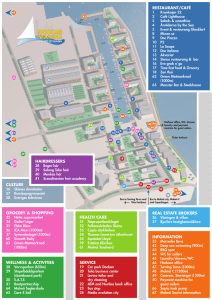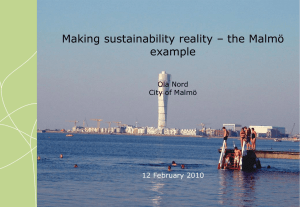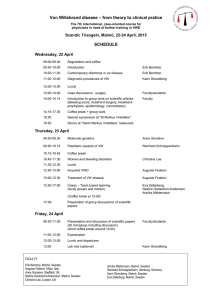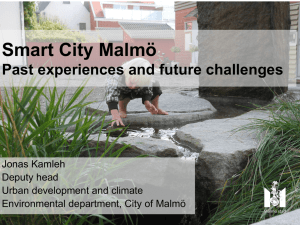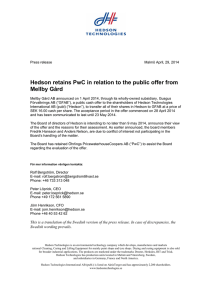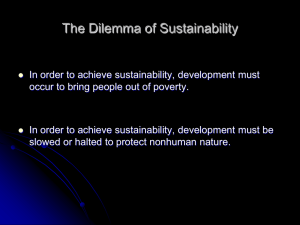Chapter for a book on cities and technology edited by Mikael Hård
advertisement
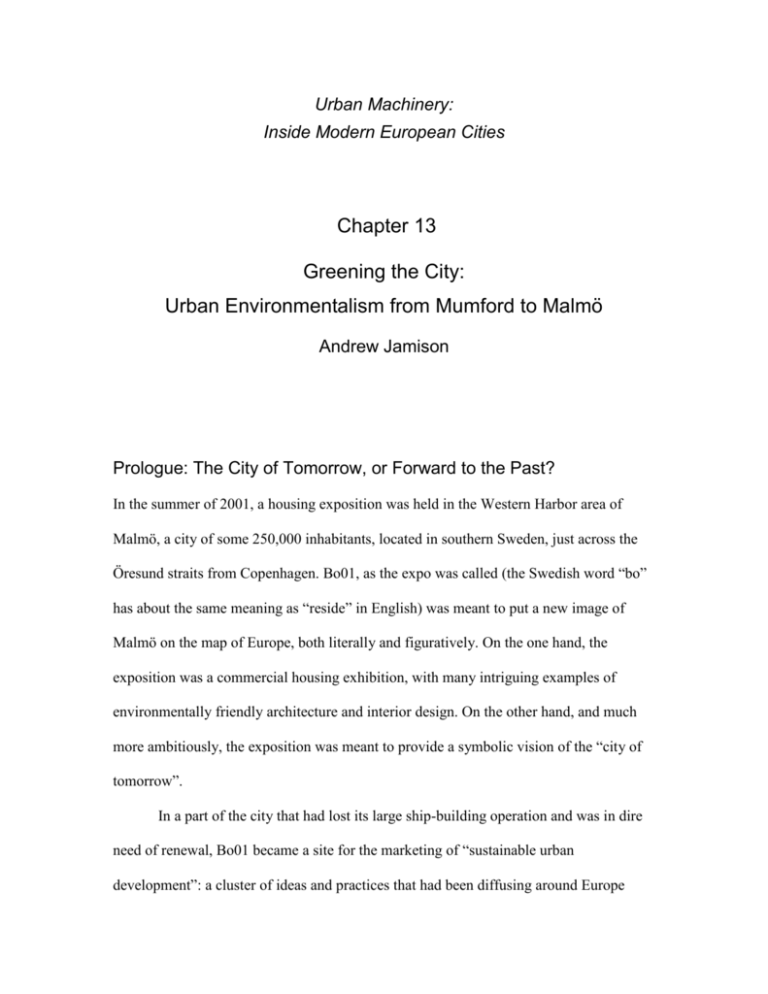
Urban Machinery: Inside Modern European Cities Chapter 13 Greening the City: Urban Environmentalism from Mumford to Malmö Andrew Jamison Prologue: The City of Tomorrow, or Forward to the Past? In the summer of 2001, a housing exposition was held in the Western Harbor area of Malmö, a city of some 250,000 inhabitants, located in southern Sweden, just across the Öresund straits from Copenhagen. Bo01, as the expo was called (the Swedish word “bo” has about the same meaning as “reside” in English) was meant to put a new image of Malmö on the map of Europe, both literally and figuratively. On the one hand, the exposition was a commercial housing exhibition, with many intriguing examples of environmentally friendly architecture and interior design. On the other hand, and much more ambitiously, the exposition was meant to provide a symbolic vision of the “city of tomorrow”. In a part of the city that had lost its large ship-building operation and was in dire need of renewal, Bo01 became a site for the marketing of “sustainable urban development”: a cluster of ideas and practices that had been diffusing around Europe 491 since the late 1980s. With the help of a newfound environmental consciousness, Malmö would cast off its industrial past and become a post-industrial city of the future: the exposition was an attempt to fashion a green image for the city. At Bo01, the displays were meant to inform and educate the visitor about the various aspects of sustainable urban development, as the organizers - who represented both the municipal government and local housing, construction and energy companies - understood it. The idea was not merely to protect, or save the natural environment, but to make money while doing so, to integrate environmental concern into economic development as a kind of “green business” (Jamison 2001). In Malmö, sustainable urban development was defined as having four components: environmental, social, technical and human. At Bo01, there were thus displays about homelessness and the plight of immigrants, as well as energy conservation and environmentally friendly construction. In addition, a few imaginative gardens designed by landscape architects showed what an ecological aesthetic might be like. Within the exposition grounds was also a site for a building that had not yet begun to rise in this city of tomorrow. At the time, it was just a huge hole in the ground, but the pictures and information material on display in the nearby exhibition hall made it clear that this was to be no ordinary structure. The Malmö office of the national company HSB, which had been established in 1928 to provide affordable housing for its primarily working class customers, had given the Spanish-born architect Santiago Calatrava the opportunity to turn a sculpture that he had made into a 55-story skyscraper. The building was to be called Turning Torso, and represented “a bold vision in modern advanced 492 architecture creating new values,” according to the exposition program; to live in it would be like living between “heaven and earth but closer to heaven” (Bo01: 46, 108). Like the Twisting Torso sculpture on which it was based, the skyscraper was to be a typically Calatravian combination of adventurous architecture and experimental engineering, and it was unclear in what way, if any, it could be considered ecologically sustainable. It was not portrayed as being particularly environmentally friendly, although the Swedish state had given several million kronor to the project for various environmental measures, in regard to energy use and waste disposal. Nor was the project described as being a part of the solution to any particularly pressing social or human problems of the city. It was rather in its architectural vision, its ambition to mix technical innovation with artistic modernism that one could perhaps read in a relation to sustainable urban development. By being a building that was meant to last, and, as such, “sustain” a modernist architectural sensibility into the future, the Turning Torso could perhaps be seen as an example of what the exposition program termed technical sustainability. The building was expected to be ready for occupancy in the spring of 2003, but like the financial calculations of Bo01 as a whole, the time plan for the Turning Torso proved to be unrealistic. At the end of 2004, the building was still not completed, and very few of the extremely expensive apartments had been sold. Because of unusually large cost overruns, the director of HSB in Malmö, who had been the instigator of the project, Jonny Orbäck, had been forced to resign, and Calatrava’s design had shown itself to be more complicated, and expensive to build than had been originally anticipated. When the grand, official opening took place in 2005, however, Calatrava was hailed by 493 city officials as a local hero, and the building was generally seen as the future symbol of Malmö that would help the city compete for the income to be derived from investors, tourists and well-heeled new residents. Figure 13.1: Fig. 13.1. Calatrava's Turning Torso is ready for tenants to move in, but still in 2006 not all of the Bo01 exhibition area had been finished. The tale of the Turning Torso provides a kind of window into the world of sustainable urban development, and, more generally, into the ways in which urban environmentalism has come to be appropriated into European cities. In the Western Harbor area of Malmö, Sweden, the city of tomorrow has met the architectural visions of the past, providing lessons for all who are concerned about the future of the city. Setting the Stage The history of urban environmentalism can conveniently be divided into three phases, or, to use a dramaturgical language, three acts. The first act recounts how a cluster of urban ecological ideas and practices emerged in a first wave of environmentalism in the late 19th and early 20th centuries. Drawing on the romantic critiques of industrialization, as well as theories and concepts from geography and history, urban reformers and “progressive” writers fashioned a cluster of social, political and scientific ideas and practices that received a kind of paradigmatic articulation in Lewis Mumford’s book, The Culture of Cities, published in 1938. The second act begins in the 1960s, as part of the new environmental consciousness that developed at the time, when many of the earlier ideas were combined 494 with new ones and circulated around the world. In many cities, experiments in such areas as environmentally friendly building construction, water management, park design and energy use were carried out in housing blocks, neighborhoods, communes and in many a previously derelict building or deserted field. In Berkeley, California activists occupied a deserted piece of land and declared it a “people’s park” which brought on the police as well as the wrath of the governor of California, the former film actor, Ronald Reagan. In Copenhagen, activists occupied a deserted military base and soon declared it to be a free town of Christiania, where, during the ensuing decades, imaginative experiments in environmentally friendly living, both in terms of design and architecture, as well as life style and behavior, would take place. It was primarily environmental movements and movement organizations, which in their various information campaigns and protest activities, spread the ideas and practices of environmental protection around Europe, and, in relation to urban environmentalism, spread the vision of a green, or at least greener city. In Berlin and Basel, in London and Amsterdam, as well as in many smaller cities of northwestern Europe, environmentally concerned architects and planners, as well as students and resident groups of various kinds, carried out experiments in “urban ecology” often in collaboration with squatters or other community activists. As an example of what was happening, we will later pay a brief visit to an exhibition that was staged during the summer of 1976 at the Modern Museum in Stockholm, where some of the experiments in energy conservation and appropriate technology that were taking place around the world were on display. Activists also spread the environmental message in Malmö in the 1970s, protesting against some of the negative effects of industrial production, and, in particular, 495 the nuclear energy plant at Barsebäck, just up the coast. At the Kockums ship-building company in the Western Harbor, which was one of the largest employers in the city, there were also discussions about “alternative production” that were organized by local activists. By the late 1980s, the plot had begun to thicken, or at least shift, as the greening of the city began to be reformulated into more instrumental terms, according to the doctrine of sustainable development, which, for cities, was translated into a discourse, or policy program of sustainable urban development. At the same time, new actors entered the scene, more or less upstaging the environmental movement “activists” who had played the leading roles in act two. The moral engagement of the activist was replaced by the more specialized competence of the expert, and urban environmentalism, we might say, was transformed into a professional activity. The third act follows a story line of appropriation, and tells of the tensions and contentions that have been associated with the implementation of sustainable urban development in particular settings, often as part of commercially oriented urban redevelopment projects. Much of the visionary idealism that was so evident in the 1970s gave way to a more institutionalized activity, and professional roles, or identities were constructed around the quest for sustainable development (see Jamison 2005). The greening of the city became the task of the specialized expert rather than the “movement intellectual,” and the arenas or sites of activity became the municipal office and consulting firm rather than the open-ended public space of the environmental movement. It was primarily in and around those areas of municipal government and public administration, which were charged with effectuating the Agenda 21 that was agreed upon at the World Conference 496 on Environment and Development in Brazil in 1992, that the implementation of sustainable urban development took place. As the ideas and practices of sustainable urban development have taken on a concrete, or material form, and in many cities literally been brought to market in commercial redevelopment schemes of various kinds, the underlying contradictions have also become more visible. In Malmö, in the continuing unfolding of the tale of the Turning Torso, this is an act that has not yet ended; indeed the entire “play” of urban environmentalism throughout Europe remains without an ending, since the tensions are yet to be resolved and the actual meaning of the efforts remains unclear and uncertain. Are cities, in the name of sustainable urban development, actually improving their environmental performance, or is “greening” in the process of becoming a marketing gimmick, helping cities compete for tourists and investments in an increasingly marketoriented and commercial age? The Emergence of Urban Environmentalism The roots of urban environmentalism—what later became known as sustainable urban development—can be traced back to the late 19th century, when reform-minded movements and individuals confronted the multifarious challenges of the industrializing city in both Europe and North America. While in Europe, critics often looked back to the cities of the past, and sought to restore or preserve the pre-industrial elements within the contemporary city, no such options were available in most of the urban centers of North America. The kinds of preservation or conservation activity that first brought William Morris, the romantic poet, into politics in the 1860s in the anti-Scrape movement, as he and others sought to save what they could of London’s historical past, were largely 497 irrelevant in the rapidly growing cities of the United States. While Morris and many other social critics in Europe objected to the ugliness of the industrial city and the loss of a sense of beauty in the industrial way of life, American reformers were, for the most part, more practical, or pragmatic, in their critique of the industrializing city. In North America, urban reform could not mean the glorification of the medieval past—for America had not had one. Rather, the growth of the cities in the 19th century inspired what might be termed the “co-construction” of a new urban landscape. American cities were pioneers in the efforts to bring nature more intimately into the modern metropolis, a bit more wildly and less tamed than in the classic European cities. New York’s Central Park became a model for other cities to follow, as did its mixture of ethnic neighborhoods, the myriad of cultural enclaves that were to give the modern or modernist city its quintessential ambiance, or what Raymond Williams (1977) has termed “structure of feeling.” The environmental challenges faced by the industrializing American city would give rise to a new sort of urban philosophy that drew on ideas from Europe, but related them to a new set of experiences (for the paradigmatic case of Chicago, see Cronon 1992). As large numbers of immigrants fled to North America from oppression in Europe, such cities as Chicago and Detroit, where new industrial corporations were growing rapidly, became key sites for further reform efforts. Some of the older cities of the northeast were also affected by the technical and organizational “innovations” that were serving to transform the American economy from a primarily rural and natural resource-based orientation to an urban and manufacturing orientation. The cities that developed were not simply in need of the greenery that parks and landscape architects 498 could provide; they required, in addition, the expertise of new sorts of scientists and engineers who could deal with the pollution of the air and the water, and the variety of public health problems that were to be found both inside and outside the conglomerations of industrial production. As Jane Addams (1910/1961: 81f.) put it, in describing the Chicago that she devoted her adult life to trying to reform: The streets are inexpressibly dirty, the number of schools inadequate, sanitary legislation unenforced, the street lighting bad, the paving miserable and altogether lacking in the alleys and smaller streets, and the stables foul beyond description. Hundreds of houses are unconnected with the street sewer…. Rear tenements flourish; many houses have no water supply save the faucets in the back yard, there are no fire escapes, the garbage and ashes are placed in wooden boxes which are fastened to the street pavements. The efforts to deal with these social and environmental problems have been characterized by historians as an important part of the “progressive” movement. Opinions have differed as to what the movement was all about (Jamison 1998), but there can be no denying that in the period between 1880 and 1940, there was a widespread interest in the United States, among geographers, planners, sociologists, social workers, as well as politicians and so-called muckraking journalists, in what might be termed the environmental problems of the industrializing city (Gottlieb 1993). In 1906 the writer Upton Sinclair published his extremely influential novel, The Jungle, depicting the plight of immigrants who worked in the food-processing industries in Chicago and providing a catalog of urban environmental problems; and at the University of Chicago, the sociologist Robert Park developed an “ecological” approach to 499 investigating the city that inspired a number of other reform-minded, or action-oriented academics. One of those who was most strongly affected by these developments was the young writer Lewis Mumford who came of age during the “progressive era” and served in the 1920s as secretary for the Regional Planning Association of America, one of the organizations that tried to act on the disclosures of the muck-rakers and the theories of the human, or urban ecologists. Mumford played an important role in consolidating the ideas and practices of urban environmentalism. He combined an interest in planning and technology with a passion for cultural history, and throughout his long life, in his many writings about the city, he sought to apply an ecological perspective to urban issues. His own mentor, as he called him, was the Scottish geographer, Patrick Geddes, but he was also influenced by the economist Thorstein Veblen, the philosopher John Dewey and the regional planner Benton McKaye (Hughes and Hughes 1990). As a public intellectual Mumford served to popularize a wide range of academic work, and make the ideas of urban environmentalism accessible for a broader audience, as well for officials and authorities in cities around the world. From his first book, The Story of Utopias (1922) to his magnum opus, The City in History (1961), Mumford provided a highly personal philosophy of urban environmentalism. In his critiques of modern architecture, highway construction, military technology as well as urban planning, Mumford continually tried to argue for a better balance between the mechanical and instrumental approaches of the “modernists” with the concern for the organic, the natural, and the living that characterized romantic critics 500 of contemporary society. As he put it in the introduction to The Culture of Cities (Mumford 1938: 9), Today we begin to see that the improvement of cities is no matter for small one-sided reforms: the task of city design involves the vaster task of rebuilding our civilization. We must alter the parasitic and predatory modes of life that now play so large a part, and we must create region by region, continent by continent, an effective symbiosis, or cooperative living together. The problem is to co-ordinate, on the basis of more essential human values than the will-to-power and the will-to.profits, a host of social functions and processes that we have hitherto misused in the building of cities and politics, or of which we have never rationally taken advantage. Mumford developed an approach to the city that attempted to place planning efforts in relation to the natural environment, or surroundings, in which the city was located. The city was to be seen as a kind of living organism, and his life-long effort was to bring the forces of life—as understood by biologists as well as artists—into the planning process. “Every living creature is part of the general web of life,” he wrote, and that ecological understanding had to become a part of urban planning: As our knowledge of the organism has grown, the importance of the environment as a co-operative factor in its development has become clearer; and its bearing upon the development of human societies has become plainer, too. If there are favorable habitats and favorable forms of association for animals and plants, as ecology demonstrates, why not for men? If each particular natural environment has its own balance, is there not perhaps an equivalent of this in culture? (Mumford 1938: 302) 501 Mumford’s ideas about city planning were perhaps more influential in Europe than in his native United States. In the decades after the Second World War, American cities tended to metamorphose into urban sprawls, the greater metropolitan regions that included the surrounding newly built suburbs and the extensive highway networks that came to transform the environment in fundamental ways. Mumford would be one of the more vocal public critics of the process, with his column in The New Yorker and his many articles in architectural and planning journals. Together with the biologist Rachel Carson and the conservationist Fairfield Osborn, and a number of other scientists and nature lovers, Mumford can be considered one of the key “ecological intellectuals” who in their public educational activity would help plant the seeds for the eventual emergence of a new kind of environmental activism in the late 1960s (see Jamison and Eyerman 1994). Urban Environmentalism in Circulation The environmental movement was one of the outcomes of the tumultuous 1960s in both Europe and North America, and it was as part of the “cognitive praxis” or knowledge production of the environmental movement that a wide range of urban environmentalist ideas and practices began to circulate, both across the Atlantic and across the national borders of Europe, as well. Economic and social developments after the second world war had brought with them a range of environmental problems – from the air pollution that contributed to the photochemical smog that Arie Haagen-Smit had identified in the skies of Los Angeles in the 1950s to the toxic waste sites that had spread like a plague across the urban landscape, as the middle classes had fled to the suburbs, to the poisoning of the rivers that had previously connected urban centers to one another. Many were the 502 voices in the 1960s that sought to educate the public about this “environmental crisis”, and by the end of the decade, a new kind of political agency had emerged in the form of activist organizations, concerned scientists, and engaged citizens (see Jamison 2001). This was a very open-ended process, both in terms of participation or involvement, as well as in terms of the ideas and practices that were considered important to circulate. Through most of the 1970s, urban environmentalism can perhaps best be thought of as a multifaceted “social movement” that combined a variety of disparate activities and political interests in one all encompassing and temporary public space (Eyerman and Jamison 1991). In the summer of 1972, the United Nations held a conference on the human environment in Stockholm that is generally considered to be one of the formative moments of the international environmental “movement” (McCormick 1991). At the time, many national governments had begun to set up state agencies to deal with the new public issues of environmental protection, which were then characterized primarily as air and water pollution and the management of waste. There were also major research programs in environmental science and technology at both academic institutions, as well as within intergovernmental and nongovernmental organizations. In North America and in many European countries, parliaments passed new laws for regulating the environmental behavior of its private and public citizens, and a number of environmental action groups were created around the world. On the eve of the Stockholm conference, a development economist, Barbara Ward and an experimental biologist, Rene Dubos, published a book that helped set the agenda for the coming deliberations Only One Earth, with the subtitle, “the care and maintenance of a small planet.” The conference served to 503 legitimate and introduce to a much wider public the various ideas and practices that had begun to be carried out in the name of environmentalism, and helped stimulate the circulation of urban environmentalism around Europe. Also important in this period was the international bestseller, The Limits to Growth, written by a multidisciplinary team of experts commissioned by the Club of Rome to forecast the future development of the world, in terms of resource and energy use, using some of the new-fangled computer modeling techniques that had emerged in the postwar period. In many European cities, groups of activists with an interest in architecture and construction carried out experiments in what started to be called “urban ecology”. There were also a number of sites for collective living in which recycling of waste products and workshops for alternative, environmentally friendly technology, were established. In London, a group of such activists put out the journal Undercurrents for many years, and in the mid-1970s produced the anthology Radical Technology in which many of these alternative ideas and practices were presented (Boyle and Harper 1976). Both the journal and the book were central agents for circulating what David Dickson (1974) at the time termed “utopian technology.” In relation to transportation, building construction, energy production and use, agriculture, and even communication, loosely organized activist networks tried to put into practice the vision of an ecological, or green city as an intrinsic part of the larger movement protesting environmental degradation and opposing nuclear energy. In Copenhagen, the activists who occupied and then settled a former military base that came to be known as Christiania, began to produce ecological products, and take part 504 in projects of ecological building construction and design as they created an alternative community in the middle of a modern city. Similar, but smaller attempts to “liberate” parts of major cities from their environmentally deleterious surroundings took place in West Berlin, Amsterdam and Vienna, as well as in many smaller cities. Major efforts at what was called ecological urban restructuring were made in West Berlin by environmentally concerned architects, where several neighborhoods and housing developments were subjected to ecological city planning (see Hahn 1986). Shut off from the countryside around them, biologists in West Berlin also pioneered the study of urban ecology, and in their scientific activity, combined an environmental consciousness with an interest in urban planning. A brief return to the ARARAT exhibition held in Stockholm in the summer of 1976 might help the reader remember the kinds of experiments and practices that were circulating around Europe at the time. On Skeppsholmen, the museum island just across the water from the Royal castle and the national parliament, the alternative technology (sub)movement put its practices on display for the entire summer (Ararat 1976). There were geodesic domes and low-energy houses that, by means of construction and design techniques, were purported to produce more energy than they utilized; there were solar heating panels and wind power plants in various shapes and sizes; there were prototypes of community gardens and urban agriculture, and, not least, there were seminars and lectures on ecological design and architecture, by which was generally meant the application of the concepts and principles of ecosystem ecology to the design and construction of buildings and other artifacts. 505 ARARAT was an acronym for “Alternative Research in Architecture, Resources, Art and Technology” and the exhibition was planned for several years by a group of architects, many of whom had been associated with the Center for Interdisciplinary Studies at the University of Gothenburg. The Center was one of the early institutional forms for the study and teaching of human ecology in Sweden, and still serves as a focal point within the university for environmental, or what is now sometimes called “sustainability science”. The ARARAT exhibition was a major event, as were many of the other displays of urban ecology in the second half of the 1970s. In the name of smallscale, appropriate technology, many development assistance projects helped to circulate environmental ideas in general and urban environmental ideas in particular from countries like Sweden to other parts of the world, and it was perhaps primarily in a developmental context that urban environmentalism had its main impact in the 1970s. In Europe, much of this experimentation with urban ecology and utopian technology more generally fell on hard times at the end of the 1970s, as conservative governments came into office and a sort of ideological “backlash” made its presence felt throughout Europe and North America. There was also an economic downturn at the time that made ecological experimentation less interesting for many European cities and governments, and, in general terms, one can refer to the first half of the 1980s as a time when urban environmentalism went into a short-term decline. Instead of experimenting with urban ecology, the technically minded became fascinated by the potential of personal computing and what were seen as enormous possibilities, both economic and social, of using the new information technologies. A kind of high-tech fever infected 506 European societies in general and cities in particular, and it became difficult for urban environmentalists to gain new adherents (Hessler, this volume). It should also be noted that, in many of the northern European countries, the energy debates of the late 1970s had served to bring environmental politics into the established parliamentary and governmental arenas. And even though nuclear energy was more or less removed from the political agenda at the end of the 1970s either by parliamentary decisions or public referenda, the energy debates led to a transformation of the environmental movement into a much broader and more differentiated political actor or actor-network. In the course of the 1980s, environmentalists in general and urban environmentalists in particular thus came to take on more specialized and professionalized social roles and identities. New types of activism emerged, as well as more delimited kinds of professional expertise. Some 15 years after Stockholm, when the World Commission on Environment and Development, headed by the Norwegian medical doctor turned politician, Gro Harlem Brundtland, published its report, Our Common Future (1987) the concept of sustainable development was launched as a new approach to environmental policy. The key was to link environmental concern with socio-economic development, and thereby transform what had primarily been until then an idealistic political program of “saving the earth” into more specialized and instrumental projects of sustainable development. At the World Conference on Environment and Development, held in Rio de Janeiro in 1992, the concept of sustainable development was made the cornerstone of the document that most of the participating governments agreed upon (the President of the United States refused to sign the 507 agreement, with the justification that “our life-style is not for negotiation”). It was with the signing of this document, the so-called Agenda 21 that the curtain falls on act two. The Appropriation of Sustainable Urban Development Only One Earth and Our Common Future were hybrid documents, in the specific sense that they combined the expertise and experience of different kinds of scientists and other experts into a new “synthesis.” In the first case, a biologist and an economist collaborated in trying to forge a new idea about environmental politics, linking the expertise of the social and the natural sciences into a program of managing, or caring for the environment; and in the second, the politicians, businessmen, scientists and environmental activists who peopled the Brundtland commission worked out another kind of political program, linking the language, or grammar of economic development with the “environmentalisms” that had been articulated in the 1970s. The conferences at which the ideas were presented—at Stockholm in 1972 and at Rio de Janeiro in 1992— can similarly be considered hybrid events, or hybrid forums, in the sense that they brought people with different interests together for deliberative purposes. They provided contexts of mediation, or sites of hybridization, which offered new opportunities for environmentalists, with more specialized interests and competence. In relation to sustainable urban development, somewhat different professional roles, or expert identities, were constructed in relation to the different facets, or dimensions of sustainability. Following the distinctions made in the Bo01 program, we can characterize the forms of professional expertise as ecological, social/human, and technical. Ecological sustainability involves primarily a natural science expertise, usually derived from systems ecology; the aim is to find particular ecosystems and ecological 508 niches in the urban landscape where various practical measures can be taken to make the city “greener”. Social sustainability involves combining environmental ideas with concepts from the social sciences and humanities, and, in Europe, a particular discourse of ecological modernization has been articulated by sociologists and political scientists in order to provide an overarching ideology, or theory, to the various projects. Technical sustainability, on the other hand, has been articulated in new approaches to architecture, construction, technology and design, and new criteria of technological innovation, which have been characterized by such concepts as industrial ecology, cleaner production, environmental management, renewable energy, and ecoefficiency. At an institutional or organizational level, actors, or agents of sustainable urban development have carved out spaces within the public and private spheres to carry out their projects. In Malmö, and many other cities in Europe, these contexts, or sites, of mediation were originally associated with Local Agenda 21 activities that were established, following the Earth Summit in 1992, in order to promote various kinds of environmentally friendly behavior at the local level (for an overview, see Lafferty 2001). In relation to such tasks as traffic planning, energy utilization, waste management, and water use, and not least access to “green areas”, cities across Europe have instituted a large number of projects of urban ecology, human/social ecology, and industrial ecology. Sustainable urban development has become a new organizational field, where specialized experts work at the interface between the public and private sectors to link ecology, or environmental concern with socio-economic development. In practical terms, the people who are employed to work on particular projects have been expected to apply their specialized competence, or training—usually in 509 environmental science or engineering—to the contexts in which they are to work. Ecological sustainability projects have often involved the application of biological, ecosystems ecology to the activity area of one or another municipal authority (for traffic, construction, energy, parks, etc). The practitioners have thus developed, in one way or another, a kind of professional identity or social role as an environmental city planner, in an emerging field of expertise that can be characterized as urban ecology. In Malmö and other Swedish cities the term “city ecologist” (stadsekolog, or kommunekolog) is sometimes used to refer to this professional role. The pursuit of social, or human sustainability has involved primarily communicative activities and what might be termed a social, or human ecological expertise. It is a kind of competence, or expertise that is fostered, among other places, in urban planning departments and “human ecology” programs at universities, as well as in the environmental subfields of the various social sciences (environmental sociology, environmental economics, etc). In Denmark, a special “green guide” program was established in the 1990s to place environmental change agents within public sector organizations and schools, and in Malmö, and other parts of Sweden, particular environmental communicators have emerged in the form of consultants, and expert advisers to municipal authorities and private companies. The environmental consultants for Bo01 were recruited both from the landscape architecture and planning divisions of the nearby Agricultural University in Alnarp, as well as from the International Institute for Industrial Environmental Economics in Lund. Technical sustainability has generally been pursued by instituting procedures and practices of environmental management in business firms. On the institutional level, this 510 has taken the form of what are generally referred to as environmental management systems, or departments of environmental management, and in practical terms, there have been a number of recent developments in such areas as cleaner technology, pollution prevention, waste minimization, ecological design and architecture, as well as more specific forms of “green engineering” in particular fields of science and technology (green chemistry, green biotechnology, renewable energy, energy planning, etc). In Malmö, there has been established a green roofs initiative, which has carried out a number of projects in ecological construction, particularly in ceilings and roofs, and there have also been a number of technical experiments, with energy saving, “sustainable” traffic planning, and, not least, water use management, in different parts of the city, especially in the area of Augustenborg. In many European cities, there have been projects in sustainable urban development that have been more explicitly related to business, or the private sector, and involved the creation of networks linking “environmental managers” from different companies with one another. These kinds of urban partnerships between the public authorities and private companies have seen in the quest for sustainable developments a potential for growth and urban renewal. But in many such efforts the ecological, or environmental aspects have tended to be downplayed while the commercial aspects have taken on the primary importance. In the course of the 1990s, a Sustainable Business Hub was established in Malmö that has arranged conferences and produced information material for local business people, and provided contacts with national and international networks, such as the World Business Council for Sustainable Development and the Greening of Industry Network. Within companies, the variety of technical activities has 511 given rise to a range of “ecodesigners” or industrial ecologists at various points in the production process. But in many of these projects, as the events in Malmö well illustrate, it has proved difficult to achieve a balance between the economic and the environmental (see e.g. Sandström 2002 for organizational approaches to greening). In Sweden, a special fund was set up in 1995 to support “local investment projects in sustainable development” (the so-called LIP-money) and the city of Malmö was successful in obtaining many hundreds of millions of Swedish kronor to carry out projects in sustainable urban development. The Agenda 21 office that had been established was gradually transformed into a LIP office, and in the late 1990s, Malmö carried out a large number of different projects in sustainable urban development with the support of LIP money. There were also activities - both projects and networks - that were funded by the European Commission, in the form of partnerships with other cities in Europe—in particular, Newcastle, Venice, Tampere, The Hague, Leipzig, and Vienna. One such network, with the acronym PRESUD (Peer Review in European Sustainable Urban Development) has brought partners from other European cities to Malmö to evaluate the efforts in sustainable urban development in Malmö, and found, as could be expected, many positive features but also a good many problems. Sustainable urban developers from Malmö have also participated in a number of looser networks, both within Sweden, as well as internationally. In 1994, the so-called Aalborg Charter was formulated at a conference of “Sustainable Cities and Towns in Europe” which has provided certain guidelines for carrying out projects in sustainable urban development. By the late 1990s, when the upcoming housing exposition that was to be held in 2001 began to be planned, it was important for the organizers to find ways to bring these 512 various activities in sustainable urban development into the planning process. It was time, we might say, for sustainable urban development to go to market. The Tale of the Turning Torso The Bo01 exposition was to be held when the new Öresund bridge connecting Malmö and Copenhagen was to be finished, and it seemed only natural that the exposition should not merely be a traditional housing exhibition but something bigger and more ambitious. The mayor of the city, the local leader of the Social Democratic party, Ilmar Reepalu, had been educated as an architect, and had already shown his political acumen, by convincing the national government to support the founding of a university college in Malmö (which started operations in 1998 and has since become a major educational establishment with over 15000 full time students). Reepalu was not alone in seeing the upcoming exposition and the reconstruction of the Western Harbor area, where the exposition was to be held, as an enormous opportunity for Malmö to improve its reputation. It had long been seen primarily as a drab, working-class city in the shadow of cosmopolitan Copenhagen. There was also, because of the LIP program, money to be obtained in greening the city, and so it was decided that the exposition would be focused around sustainable urban development, and thereby encourage the exhibiting companies to think about projecting a more ecological image. A group of housing officials, municipal civil servants, and representatives of both companies and environmental organizations was set up to plan the exposition, which gradually grew into a major manifestation. Bo01 received some 250 million kronor (and Turning Torso some 5 million kroner) from LIP, and funds were collected from many other sources for what became an effort to market Malmö as the sustainable city of 513 tomorrow. The budget was not able to be kept, however, which led to the bankruptcy of the planning committee soon after the exposition was closed down. While other cities in the vicinity had recently held housing exhibitions—the small, suburban town of Staffanstorp had held one in 1997 and Helsingborg, a larger city up the coast, had held one in 1999—Bo01 in Malmö was thus going to be something different. It was not only, or even primarily, to be about housing; it was going to be about sustainable urban development. Landscape architects were invited to create imaginative gardens, to bring out some of the more complicated natural processes involved in sustainable urban living (what happens to waste and how water is supplied and managed, for example). Unfortunately, the gardens were destroyed after the exposition, as were most of the ecological restaurants and cafes that dotted the grounds. There was an exhibit about homelessness, with films and lectures portraying some of the serious social problems of the contemporary city. There were efforts made to involve immigrant groups in the exposition, but it proved difficult to compete for their time with their involvement in the annual Malmö festival, which, unlike Bo01, is a free cultural manifestation and urban fair that is held for a week every August. Sydkraft, the local energy company devoted an entire building to its work with renewable energy, which included demonstrations that aimed to explain how the city of tomorrow was to be self-sufficient in terms of energy use. “Taking the year as a whole,” Sydkraft wrote in the exposition program, “the number of kWh consumed equals the number generated” (Bo01: 48-49). Fig. 13.2. Ecologically inspired, low-energy row houses on the Bo01 exhibition area in Malmö. 514 According to the advertising and marketing, the prime purpose of the housing expo was public education (what in Swedish is called folkbildning) in the broadest sense: according to the program, the ambition of Bo01 was “to start a debate on how we wish to live in the city of tomorrow,” and a wide range of educational institutions and cultural debaters had been invited to take part in discussing what the program called “active citizenship.” (BoO1: 25). For anyone who visited the exposition, it was clear that sustainable urban development was meant by the organizers to be a multifaceted cultural process, and required the emergence of new ideas and practices, but, perhaps most importantly of all, new values and identities. A few years later, however, it is rather difficult to find those values, even though there is a lot of expensive and rather impressive housing in the area. Instead of fostering new ecological values, the Western harbor area has become most renowned for being the site of the Turning Torso. In 1998, Santiago Calatrava, who had unsuccessfully bid for the design of the Öresund bridge, attended a meeting at which the bridge and the exposition were presented. Jonny Orbäck, the director of the Malmö office of the HSB housing company, which was one of the active partners in the Bo01 consortium, talked with Calatrava about the possibility of his making a contribution, and a few months later, Orbäck and a group of city officials visited Calatrava in Switzerland in order to discuss further what his contribution might be. It was at that time that Orbäck saw a model of the Twisting Torso sculpture and had the idea of suggesting to Calatrava that he make a building of it on the exposition site. Calatrava had not designed apartment buildings before, but found the idea intriguing, and not long thereafter, the contract for the Turning Torso was signed. 515 Santiago Calatrava is one of the more outspoken modernist architects of our time, not noted, in any of the voluminous literature about him, for an environmental sensibility or an interest in sustainability. He made his reputation by designing bridges and railway stations that combine an artistic creativity with a fascination in processes of physical motion and what he has termed the “foldability” of metal materials (Jodidio 2003). He was educated both in architecture and engineering, and his constructions display an aesthetic interest in abstraction and a susceptibility to what might be called technological hubris: doing the impossible and transcending previously recognized limits. There is an experimental playfulness in his work that is reminiscent of Antonio Gaudi and Joan Miro, two of his main sources of inspiration. And there is certainly an impressive symbolic ambition in everything he does: as he has been quoted as saying, I believe that one of the most important tasks is to reconsider the periphery of cities. Most often public works in such areas are purely functional, and yet even near railroad tracks, or spanning polluted rivers, bridges can have a remarkably positive effect. By creating an appropriate environment they can have a symbolic impact whose ramifications go far beyond their immediate location (ibid.: 12). This interest in what Calatrava calls transgression has characterized modern, or modernist architecture since it first emerged in the nineteenth century. In the words of Lewis Mumford (1962:166), “the first erections of modern architecture, beginning with the Crystal Palace in 1851, rested on a firm foundation: the perception that the technology of the nineteenth century had immensely enriched the vocabulary of modern form and facilitated modes of construction that could hardly have been dreamed of in more ponderous materials.” The natural environment was not so much to be respected and 516 lived in; rather the aesthetic ambition of modern architecture - especially as it grew into the modernism of Le Corbusier and others—became the transcendence of the natural surroundings and their replacement by the artificial and abstract “nature” visualized and given material form by the designs of the technologically infatuated architect. To live in the Turning Torso is to live in a work of art, it is certainly not to adapt one’s way of living to the surrounding environmental conditions. It is perhaps not too surprising that there were not very many people in Malmö who were initially interested—or rich enough—to acquire one of the apartments; in a city afflicted with more than its share of homelessness and suffering from a high degree of cultural segregation in its housing “market”, the building can be seen to represent a rather problematic interpretation of sustainable urban development. Conclusions The tale of the Turning Torso offers an illustrative example of the cultural tensions of sustainable urban development and sustainable development in general. The quest for sustainable development has met a number of constraints, or barriers since it was articulated as the cornerstone of a new international “agenda” in Brazil in 1992. The ambitions of what might be termed the sustainability scenario have been countered both by the commercial ambitions of the global marketplace, as well as from might be termed the aesthetic assumptions of modern architecture. From such a perspective, the Turning Torso represents, in a particularly unholy alliance, the twin pressures of the market and the past. Both commercialism and modernism have served to reduce sustainable urban development to the traditional urban planning project of building impressive buildings. Of course, lip service has been paid, 517 conveniently enough with the support of “LIP” money, to environmental concern in the construction plans—renewable energy and building materials are to be used, wherever feasible, and ecological design is to be encouraged in the individual apartments—but the discourse in which the building is presented is undeniably modernist. And as it towers over the rest of the city and indeed the rest of southern Sweden, the Turning Torso provides a symbol for the contemporary city that seems remarkably like the symbols of the past. Instead of the huge Kockums crane—Malmö’s industrial symbol par excellens, which has been shipped off to South Korea along with the ship-building business—an artistic skyscraper reaches for the sky, telling an all too traditional story of technological hubris. The city of tomorrow has thus been captured by the modernist architecture of yesterday, and while the quest for sustainable urban development continues to take place in Malmö, the future seems to have been postponed. References Addams, Jane (1910/1961) Twenty Years at Hull-House. New York: New American Library . Ararat (1976) ARARAT. Alternative Research in Architecture, Resources, Art and Technology (exhibition catalog). Stockholm: Modern Museum Bo01 (2001) Framtidstaden Mässkatalog (exposition catalog) Malmö 518 Boyle, Godfrey and Peter Harper, eds (1975) RadicalTechnology. London: Wildwood House Cronon, William (1992) Nature’s Metropolis: Chicago and the Great West. New York: W.W. Norton. Dickson, David (1974) Alternative Technology and the Politics of Technical Change. Glasgow: Fontana Eyerman, Ron and Andrew Jamison (1991) Social Movements. A Cognitive Approach. Cambridge: Polity Gottlieb, Robert (1993) Forcing the Spring. The Transformation of the American Environmental Movement. Washington: Island Press Hahn, Ekhart (1987) Ökologische Stadtplanung: Konzeption und Modelle. Frankfurt/Main: Haag + Herchen Hughes, Thomas and Agatha, eds (1990) Lewis Mumford: Public Intellectual. New York: Oxford University Press Jamison, Andrew (1998) American Anxieties: Technology and the Reshaping of American Values, in Mikael Hård and Andrew Jamison, eds (1998) The Intellectual 519 Appropriation of Technology. Discourses on Modernity, 1900-1939. Cambridge, Ma: MIT Press Jamison, Andrew (2001) The Making of Green Knowledge. Environmental Politics and Cultural Transformation. Cambridge University Press Jamison, Andrew (2005) Participation and Agency: Hybrid Identities in the European Quest for Sutainable Development, in R Paehlke and D Torgerson, eds, Managing Leviathan. Peterborough, Ca: Broadview Press Jamison, Andrew and Ron Eyerman (1994) Seeds of the Sixties. Berkeley: University of California Press Jodidio, Philip (2003) Santiago Calatrava. Köln: Taschen Lafferty, William, ed (2001) Sustainable Communities in Europe. London: Earthscan McCormick, John (1991) Reclaiming Paradise: The Global Environmental Movement. Bloomington: Indiana University Press Mumford, Lewis (1938) The Culture of Cities. New York: Harcourt, Brace and Jovanovich 520 Mumford, Lewis (1962) The Case Against ‘Modern Architecture,’ in Architectural Record, reprinted in The Highway and the City (New York: Harcourt, Brace and World) Sandström, Johan (2002) Organizational Approaches to Greening: Technocentrism and Beyond. Umeå, Sweden: Umeå University. Ward, Barbara and Rene Dubos (1972) Only One Earth: The Care and Maintenance of a Small Planet. London: Andrew Deutsch Williams, Raymond (1977) Marxism and Literature. Oxford University Press
